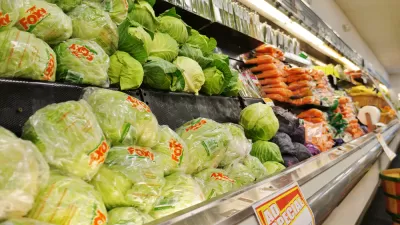Food Deserts
What's Wrong With Walk Score's Food Desert Map
Walk Score’s new food desert map is a potentially powerful tool in the ongoing policy debate about access to healthy foods. But it’s still a work in progress.

How Easy is Walking to the Grocery Store in Your City?
Angie Schmitt shares news of an effort by WalkScore to rank cities based on the ability of residents to access grocery stores on foot. WalkScore invites planners all over country to use their data to improve walkable access to food in cities.
Atlanta’s Food Desert Problem
An estimated 500,000 residents of the Atlanta area live without access to grocery stores. A recent article asks the obvious question: “Why can we build multimillion-dollar highway systems and multibillion-dollar stadiums but not more grocery stores?"
Minneapolis Scales Back Healthy Food Program
Minneapolis’ Healthy Corner Store Program launched with lofty ambitions in 2009—to help corner stores market and sell fresh food—but lackluster performance has required the city to reduce the scale of the program.

Report: Improving Food Deserts Doesn’t Improve Health Outcomes
A new study published in the February issue of Health Affairs presents evidence that providing fresh food in food deserts does not improve diets or health outcomes for residents.

Food Stamps and Place: New Cuts Could Dry Up Food Desert Improvements
Perhaps the only greater injustice than the existence of food deserts is a willing and unfeeling action to re-create them.
Market on Wheels Serves Chicago's Food Deserts
A nonprofit has converted a former Chicago city bus into a mobile grocery store to bring fresh food to the city's underserved neighborhoods. After stopping operations in August, the service will return with a sustainable business plan this month.
Effort to Reduce Food Deserts Finds Spring of Success in Chicago
Chicago has good news to report in its battle to improve access to fresh healthy food. Since Rahm Emanuel became mayor more than two years ago, the number of residents living in food deserts has declined by 21 percent.
Mobile Oasis Brings Healthy Options to Manhattan Food Deserts
Access to affordable healthy food is a problem in poor communities throughout the U.S. Manhattan Borough President Scott Stringer and a local non-profit have developed one way to quickly boost the healthy food infrastructure in food deserts.
In America's Cities, the Better-Off Trade Retail for Restaurants
The replacement of retail establishments with restaurants in America’s urban centers has a demographic slant.
Will L.A. Overturn a Controversial Fast Food Ban?
After four years of banning the construction of new stand-alone fast food restaurants in South L.A., the city's planning department is considering raising the ban amid increasing questions about the impact of food deserts on obesity.

New Study Raises Questions About Relevance of Food Deserts
The role of access to fresh food in contributing to people's eating habits has been at the heart of efforts to identify and eliminate 'food deserts.' However, a new study questions the connection between obesity and the food environment.
New Tool Improves the Search for Food Deserts
The USDA's new Food Access Research Atlas provides a handy guide for assisting policymakers and planners in finding the urban and rural areas with the most formidable obstacles to accessing fresh healthy food, reports Nancy Shute.
The Demise of Fresh & Easy: What Does It Mean for Food Deserts?
What does the impending demise of the Fresh & Easy grocery chain mean for food deserts? Hannah Burton Laurison and Christine Fry look at how small-format grocery stores can still succeed where Fresh & Easy failed.
Mapping Food Deserts in New Orleans
New Orleans has only one supermarket for every 350,000 residents, and they are often in locations that are more than a mile from where low-income residents live, writes Rosa Ramirez.
Cost, Rather Than Compass, May be Key to Healthy Eating
Efforts to alleviate urban food deserts has focused on the proximity of healthy food choices as a correlating factor for obesity. However, a new study concludes that price, rather than proximity, has a stronger correlation to rates of obesity.
Will Philadelphia Experiment Alter the Course of American Food Policy?
With the highest obesity rate and poorest population of America’s big cities, Philadelphia is launching an ambitious plan to increase residents' access to healthy food, reports Sarah Kliff.
Six Ideas for Building Food Oases
With low-income children much more likely to be overweight than their wealthier counterparts, Sarah Parsons looks at six innovative ideas for improving access to healthy foods in low-income communities.
Refuting the Recent Food Access and Obesity Findings
Allison Karpyn, Ph.D., director of research and evaluation for the Food Trust, shares her doubts about the overall implications of recent studies questioning the concept of Food Deserts and their connection to obesity.
Studies Shoot Down Concept of Food Deserts and Their Link to Obesity
Gina Kolata reports on the findings of two new studies that question the very concept of food deserts in poor neighborhoods, and the connection between fresh food access and obesity.
Pagination
Urban Design for Planners 1: Software Tools
This six-course series explores essential urban design concepts using open source software and equips planners with the tools they need to participate fully in the urban design process.
Planning for Universal Design
Learn the tools for implementing Universal Design in planning regulations.
Caltrans
Smith Gee Studio
Institute for Housing and Urban Development Studies (IHS)
City of Grandview
Harvard GSD Executive Education
Toledo-Lucas County Plan Commissions
Salt Lake City
NYU Wagner Graduate School of Public Service


































